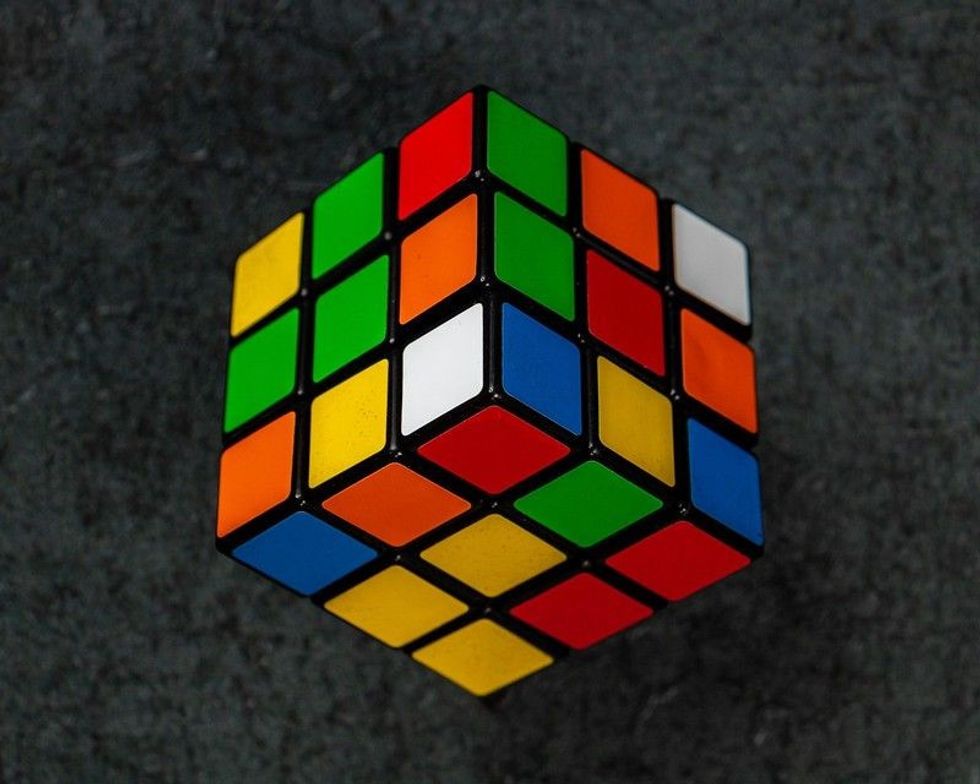Cubes are considered blocks where the length, the breadth, and the height are of equal measurements, and a cube's shape is considered 'cubic.'
Cubes are exceptional square-faced prisms; a cube is a part of the platonic solids, and it is considered a convex polyhedron where all its faces are squares. An authentic isometric cube has octahedral (eight faces) or cubical symmetry.
A cube is a solid three-dimensional figure that features all right angles where height, width, and depth are equal. It consists of six square faces, eight vertices (a vertex is a point), and three edges meeting at one vertex point. We can call a cube a square parallelepiped, i.e., an equilateral cuboid and a right rhombohedron.
The most common daily life example is a dice with six sides, the same as a cube with eight vertices and 12 edges. Most dies are cube-shaped, having numbers from one to six on different faces.
Solid geometry is all about three-dimensional shapes which have surfaces and volumes. Some other shapes are a cuboid, a cylinder, a cone, and a sphere. A cube has the most significant volume of all cuboids with a specific surface area.
11 different polyhedral nets can be made by folding six square faces of a cube. A cube has 11 polyhedral nets, which means we can flatten a cube in 11 different ways by cutting its seven edges.
You can cut a single cube into six identical square pyramids. It is also unique as it has an even number of sides on its faces, and every face has symmetrical vertices. A cube is three-dimensional, and the same refers to spheres, cylinders, cuboids, cones, pyramids, square-based pyramids, and triangular-based pyramids.
Geometry is fascinating and fun when we dig deep as there are various formulas and methods, just like in math. It is interesting work to determine the exact values and solutions. Kids show a lot of interest in geometry because we can find these geometrical structures like cubical ones in our day-to-day life. Let's go much deeper into cubes.
Read on and also enjoy our other articles like how many earths can fit in the sun and how many ribs does a human have, after checking out all our additional information about cubes.
How does a cube have 12 edges?
Six identical faces join at the edges of a cube; they're also called squares in a region.
All square faces have four equal sides, and all four interior angles are right angles. Three edges join at each corner, called a vertex.
Among the five platonic geometrical solids, only the cube is a hexahedron. It has 12 edges because all square faces are identical, forming a total number of 12 edges of the same length. A cube has vertices that are eight in number.
Line segments connecting the opposite corners of squares' faces are called face diagonals. A diagonal can be drawn from one vertex to its diagonally opposite vertex.
Each square face has two faces that constitute 12 in the cube. A mathematical formula is used to measure the length of a diagonal face. All the diagonals in a cube are equal and meet the edges at the eight vertices.
Generally, all cubes have 12 edges and eight vertices, whereas it would be different for the cuboid. A cuboid has the same edges as a cube, but the edges are different in length.
How do you find the edges of a cube?
A cube is a three-dimensional figure with eight vertices. A line segment joining two vertices is called an edge. Edges are straight lines in a cube. If you take a closer look and count these straight lines, you can find a total number of 12 edges in a cube.
Square faces have four edges, and as it moves from one position to another, each of its four vertices will trace out an edge. We have four edges on the initial square faces and four on the final square faces, and four are traced out by moving vertices, and the total number would be 12.
The basic pattern repeats as we go forward; this way, we can find the edges of a cube.
Face diagonals of a cube have six square-shaped faces with two diagonals on each face joining the non-adjacent vertices. Thus we can say that a cube has 12 face diagonals.
We can better understand this by a cube math formula that helps us find the cube's surface area, diagonals, and volume. The volume of a cube = a3, and the answer is written in in3, cm3, or any cubic unit depending on your choice.
We have something called a Rubik's cube with eight corner cubes and 12 edges cubes. It consists of many sides. The mathematical formula used for determining Rubik cube edges when scrambled in a number of ways is (388!)( 21212!)/12.
How many straight edges do cubes have?

A cube has various properties, and this concept occupies a vital position in geometry.
When it comes to the properties of a cube, the angle between any two faces or surfaces is 90°; the opposite planes or faces opposite each other in a cube are actually parallel to one another; the same is referred to as opposite edges.
The vertices' edges meet the three faces and three edges; each face in a cube meets four other faces. The line that joins two adjacent vertices in a cube is the diagonal of a cube.
Each diagonal of each of the faces forms the hypotenuse of a right-angled triangle. You have a total of 12 face diagonal and four main diagonals that connect the diagonally opposite vertices of the cube.
All the edges in a cube are straight lines, and they follow the linkage vertices. There is a total of 12 straight lines in a cube.
To count them or understand them correctly, it's always recommended going step by step initially by drawing the cube and later counting each straight line, also called edges, and then the answer will be clear.
A cube has 12 straight lines.
How many edges does a cube have in 3D?
Three-dimensional shapes are blown-up shapes. Examples of 3D shapes are spheres, cuboids, cylinders, cones, triangular based pyramids, and square face-based pyramids.
3D shapes depend on the number of edges, faces, corners, and sides of each shape. These corners are the point of connection called vertices. The largest surface area of a shape is a face. Some faces can be flat and some faces can be curved; for example, a cylinder has two flat faces and one curved face.
An edge is where two faces meet. An edge can be straight or curved; for example, a cube has 12 straight edges. Properties of three-dimensional shapes depend on the number of faces, the number of edges, and the number of vertices it has. When three edges meet, it is called a corner.
For instance, a cube has eight corners, just like a cuboid. A sphere has no edges and no corners. A square-based pyramid, a triangular-based pyramid, and a cone have vertices on the top.
In 3D shapes, a cube consists of six faces, 12 edges, and eight vertices. 3D shapes have length, width, as well as depth, unlike 2D shapes.
Here at Kidadl, we have carefully created lots of interesting family-friendly facts for everyone to enjoy! If you liked our suggestions for how many edges does a cube have take a look at amazing Atlantic Ocean animals or how is popcorn made.









